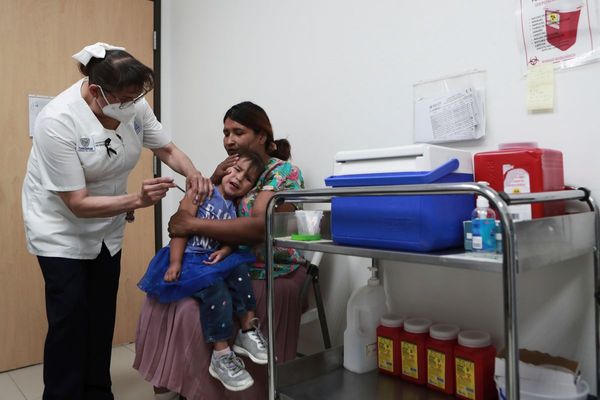
In America, the fate of the abortion drug mifepristone is currently hanging in the balance. Following the fall of Roe v Wade — the decision that guaranteed abortion rights across the US — the Supreme Court is now considering whether to uphold the ruling of a Texas judge to revoke the pill’s approval by the Food and Drug Administration, which dates back to 2000.
Australians may shake their heads at the demise of Roe v Wade, but nonetheless, through a combination of complacency and political cowardice, we have failed to properly secure reproductive rights at home.
Here, mifepristone is better known as RU486, the drug Tony Abbott fought to keep his boxer’s fists clamped around as health minister in the form of a ministerial veto. The man who called abortion the “easy way out” was determined to make it harder to access, aided and abetted by John Howard, who effectively banned mifepristone in 1996 as a concession to independent senator Brian Harradine in return for supporting the partial privatisation of Telstra.
While globally people had been medically terminating pregnancies for decades, Australians now had no choice other than to undergo surgical abortions, no matter how early their pregnancy. Mifepristone only made it onto the Pharmaceutical Benefits Scheme in 2012, making Australia, which likes to see itself as a leader in sexual and reproductive health, one of the last industrialised countries to make the abortion pill widely available.
Ten years later, we are still playing catch-up. Nearly a third of women live in areas where mifepristone is unavailable due to a lack of doctors registered to prescribe it, and the problem is more acute in remote areas and among First Nations communities. Despite having a sparsely scattered population that would benefit greatly from access to medical abortion, the Northern Territory did not have a single GP who could prescribe it as of 2019.
Abortion lottery
Australia can’t get its act together to collect robust national data on the annual abortion rate, but best estimates suggest medical abortion accounts for just one in five pregnancy terminations (these figures, from 2019, do not account for the pandemic, which globally increased the use of abortion pills due to lockdown measures). In Finland, by contrast, medical abortion accounts for 98% of terminations.
As in the US, access to abortion in Australia is a state-based lottery. Abortion deserts stretch for hundreds of kilometres and terminations cost hundreds of dollars that many people don’t have. Conscientious objection can force pregnant people to shop around for doctors as they approach, or surpass, the legal gestational limits for terminating a pregnancy.
As of 2018, Tasmania has no dedicated abortion clinics left. Heading west from Brisbane, abortion services stop at Toowoomba. The list goes on. We are, after all, talking about a country where a prime minister traded away abortion rights to rid himself of a meddlesome telecommunications company.
Avoiding pregnancy in Australia is more expensive and difficult than it should be, and not even the doctors are on the right side. In its submission to the current Senate inquiry into universal access to reproductive healthcare, the Royal Australian College of General Practitioners opposed extending mandatory bulk billing to abortion pills because “general practices are small to medium-sized enterprises which have faced significant and sustained viability pressures and increased overheads over the last decade, which have worsened during the COVID-19 pandemic”.
Of course, women and gender-diverse people have also sustained increased overheads due to the pandemic, but will someone please think of the small to medium-sized enterprises?
The submission goes on: “If practices become financially unviable and are forced to close, patients will no longer have access to high-quality, local and accessible general practice care.” This seems unlikely, as only 10% of Australian GPs have even bothered to register to prescribe medical abortions in the first place, but bankrupting doctors’ surgeries would just be one addition to the long list of societal ills people think they can blame abortion for.
The Australian College of Midwives has more sensibly suggested their members be given the power to prescribe abortion pills, something French midwives have been doing since 2016 without incident — indeed, trials are taking place that would allow them to perform surgical abortions too.
A vital lifeline
The radical power of mifepristone is that it places not just the decision to end a pregnancy but the ability to do so directly in the hands of the only person who should have a say: the patient. Witness the scores of people around the world who were able to self-manage abortions at home during the pandemic with pills ordered online. The people of Poland, a nation of 38 million, rely almost entirely on pills by post (or in the past by drone) to circumvent the country’s near-total ban. Medical supervision certainly helps, but it shouldn’t become a financial cudgel to wield over people trying to access a treatment that is 95% effective with a safety rate of more than 99%.
This is why the US mifepristone decision is so important. Despite the efforts of the religious extremists in red states to force adults and children alike into giving birth against their will, the availability of abortion pills provides a vital lifeline. In anticipation of the Supreme Court once again deciding to condemn women and gender-diverse people to second-class citizenship, reproductive rights activists are now circulating information on how to end a pregnancy using misoprostol alone. It is not ideal, but it can be done.
It’s been clear since mifepristone was first approved in 1988 that it is safe and effective. In places where it has been made available for free and without unnecessary regulation, this drug has been as revolutionary as its creator intended. If the extreme right succeeds in getting it banned in the US, they will be to blame for definitively yanking the liberty to choose out of the hands of millions.
In Australia, the lack of access to mifepristone can be blamed on a more prosaic combination of apathy, over-regulation and the original sins of an unholy trinity: Harradine, Howard and Abbott.







